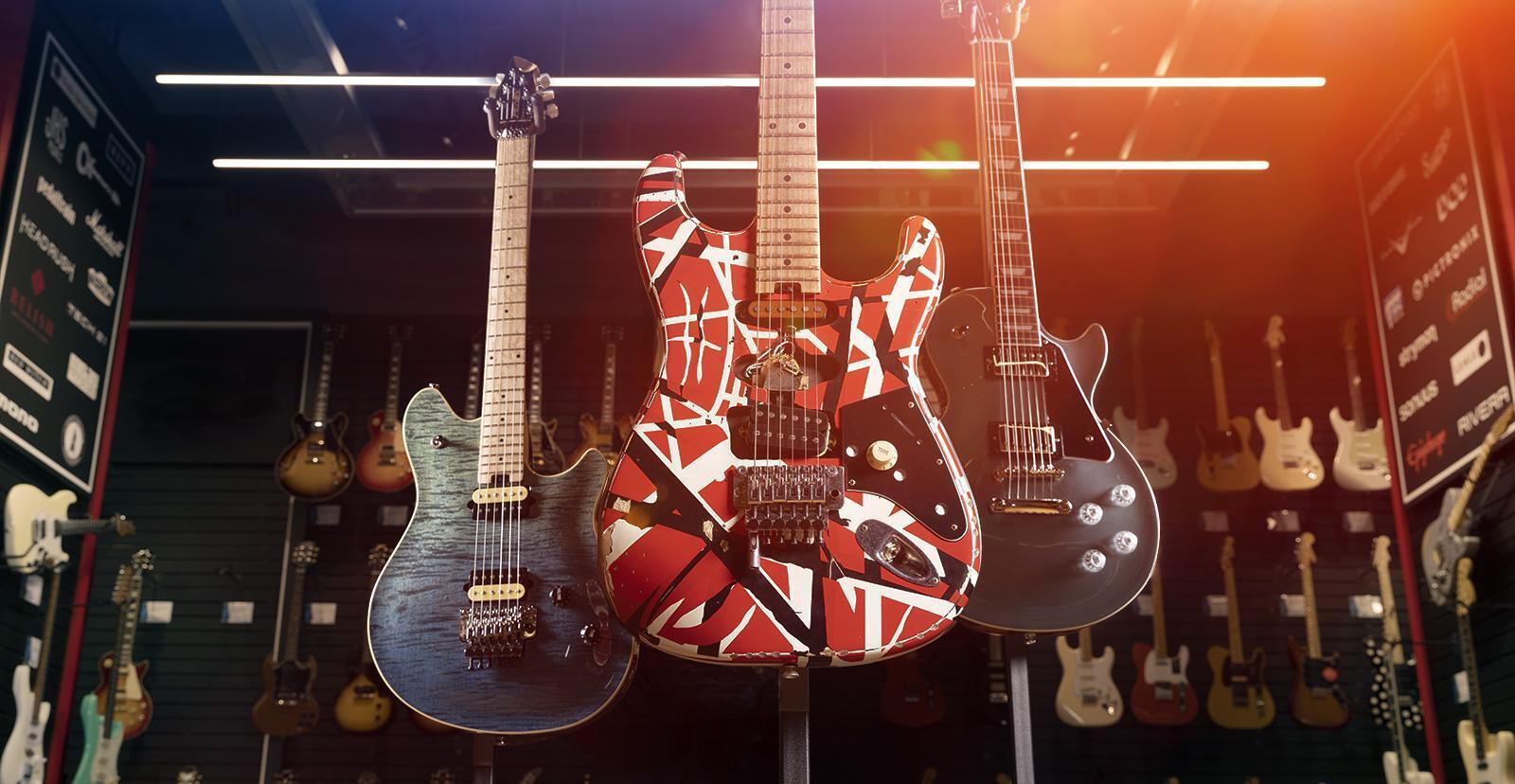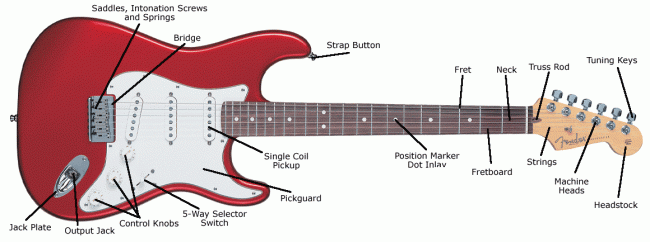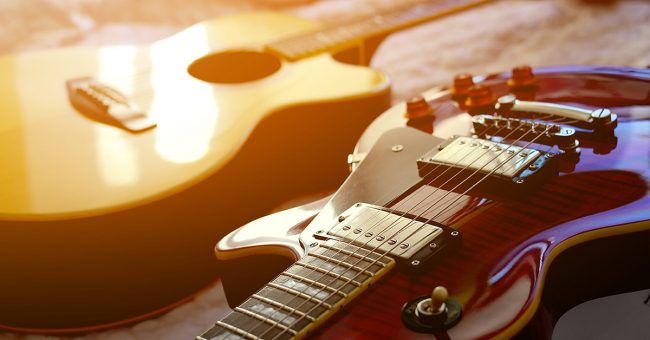How to Choose an Electric Guitar
Who hasn’t dreamed of playing guitar in front of thousands of screaming fans? We might not be able to help you play any better, but we can put the right axe in your hands! This Sweetwater Buying Guide includes information that can help you choose an Electric Guitar for your needs. Since there’s so much to consider when purchasing an Electric Guitar, don’t hesitate to call (800) 222-4700 for more information.
- The anatomy of an electric guitar
- Tonewoods: sonic signatures
- Three bodies, three different sounds
- How a pickup can influence your sound
- Guitar necks explained
- Do frets matter?
- What to look for in an electric guitar
First-time electric guitar buyer? Not quite sure what you're looking for? Have a look at our beginner guides first.
The anatomy of an electric guitar
Parts of an electric guitar
Electric guitars are available in a wide diversity of body styles, tonewoods, and electronics. We’ll discuss some of the important aspects below. You can learn more about the individual components in this article: “Parts of a Guitar.”
Guitars are made up of tonewoods, strings, hardware (metal and plastic), and electronics — all working together to create a music machine.
Tonewoods for electric guitar: sonic signature
Since the earliest days of music, instruments and woods have had a relationship, and electric guitars are no different. The woods used in electric guitars are often referred to as tonewoods. These are are well known for having desirable tone and sustain when used in musical instruments. It’s interesting to note that the wood itself takes on different characteristics depending on which part of the guitar it’s used for.
The woods listed below are the most commonly used tonewoods for electric guitars, though you will find others. Even though one guitar may have the same tonewoods as another, they may still sound very different.
Common Tonewoods
Alder
Light weight with balanced tone.
Ash
Open grain with balanced tone, great for transparent finishes.
Basswood
Light weight and warm sounding, with strong mids.
Korina
Medium to heavy weight wood, very warm sounding, less highs.
Mahogany
Medium to heavy weight, very warm with great sustain.
Maple
Medium to heavy weight, very bright with long sustain.
Poplar
Light weight hardwood, bright and crisp.
Common Neck Woods
Maple
Dense, hard and strong, very bright sounding with great sustain.
Mahogany
Very warm and fat sound.
Fretboard Woods
Maple
Dense, hard, and strong, fast playing, very bright sounding with great sustain.
Rosewood
Plays smooth and fast with very warm tone.
Ebony
Very hard wood, smooth and fast playing, very bright sounding with long sustain.
Pau Ferro
Very hard wood, fast and smooth playing, brighter than rosewood, warmer than ebony.
Three bodies, three different sounds
Electric guitars come in three basic varieties: solidbody, semi-hollowbody, and hollowbody. Solidbody guitars have… well, solid wood bodies. The hollowbody guitar is built like an acoustic guitar with a completely hollow inside. And a semi-hollowbody guitar adds a solid center block to a hollowbody design.
How a pickup can influence the sound of your electric guitar
Single-coil pickups
The first electric guitars all used single-coil pickups. A single-coil pickup has only one coil of wire. It may have a single magnet, a single magnet with screws for adjustable pole pieces, or a separate magnet for each string. Regardless of the number and arrangement of magnets, it is still a single coil pickup if it has only one coil of wire.
Unfortunately, in addition to producing an electrical signal from a vibrating magnetic field, a coil of wire is a very efficient antenna. A coil of wire will “pluck” electromagnetic radiation out of the air, and we are surrounded everywhere by this radiation – most notably the sixty-cycle hum from building wiring, electrical noises from fluorescent lighting, and the most recent source of noise troubling guitarists with single coil pickups: the computer monitor. In short, single-coil pickups are susceptible to hum.
The single-coil sound
Single-coil pickups have a thin, clean, and transparent sound. These pickups are usually about 3/4th of an inch wide and 2-1/2 inches long. Single-coil pickups are common on Fender guitars such as the Stratocaster and Telecaster, two guitars that are very common in rock, country, and pop. Some of the most notable users of the Fender Strat single-coil sound include Jimi Hendrix, Eric Clapton, and Stevie Ray Vaughan. Famous Telecaster players include Bruce Springsteen, Buck Owens, and Johnny Paycheck.
Humbucker pickups
As early as 1935, Gibson introduced the first electro-magnetic pickup, referred to as the “bar.” The first model this appeared on was the Gibson “Hawaiian Electric,” but was quickly adapted to the ES-150 model by 1936 and Gibson banjos by 1938. Made famous by electric guitar pioneer Charlie Christian, the “bar” pickup was extremely successful. Even today it is known as the “Charlie Christian” pickup.
In the 1950s Ted McCarty, president of Gibson and an engineer by training, assigned Walt Fuller and Seth Lover the task of designing a pickup that would not be prone to “humming” in the presence of transformers, rheostats, and other electrical interference. Lover began work in 1954 and a year later filed a patent application for a pickup that utilized two coils to cancel or “buck” the hum, commonly known as “humbuckers.”
A humbucker uses two coils and either two magnets (or sets of magnets), or pole pieces at opposite ends of a single magnet. Contrary to popular belief it is incorrect, or at least very misleading, to say that the two coils are “out-of-phase.” When speaking strictly of electrical coils by themselves, they are said to be “in-phase” when they are wound the same direction. However, pickups are said to be “in-phase” when their signals are in phase (the signal generated in one pickup adds to the signal generated in the other, instead of subtracting from it). In a humbucking pickup, the two coils are wound with opposing electrical polarity, but the magnetic polarity for each coil is also reversed. Without going into great technical detail, this means simply that each coil carries two signals; the string vibration signal, which is reinforced, producing a thick, meaty sound, and the noise signal, which is cancelled.
The double-coil sound
The humbucker was featured on two models of Les Pauls in 1957, the goldtop Standard and the three-pickup Les Paul Custom. The warm, smooth, double-coil sound of the Gibson Les Paul is a favorite for rock, blues, pop, and jazz. While most of the guitarists mentioned above have played Gibson guitars, the most famous players whose sound is associated with the double-coil “humbucker” sound include Jimmy Page, Joe Perry, John Lennon, BB King, Wes Montgomery, and Chet Atkins.
Many guitars have a combination of single- and double-coil pickups. It’s also common for a double-coil pickup to have a switch that will turn one of the coils off to offer the player a choice between single- and double-coil.
Electric guitar necks explained
If you haven’t figured this out by now, no two guitarists are alike, and their preferences about their favorite guitars vary widely. That extends to guitar necks, too – you’ll find an almost bewildering variety offered by different guitar makers! But we can pare down the neck issue to three important factors: the wood (type and number of pieces), the neck joint (how it connects to the guitar’s body), and the profile (the width, thickness and shape).
What wood you do?
Whether your guitar’s neck is one piece or made of two or more sections laminated together – this often makes the neck stronger – the wood used to make it is an often-debated topic. The issues center on the “hardness,” determined by the tightness of the wood grain, and the weight, a crucial factor in constructing a balanced guitar. Here’s a brief description of some commonly used neck woods:
- Maple – This was what Leo Fender used on the first solid-body electric (which became known as the Telecaster). Maple is medium hard and medium weight, which worked well without causing the guitar to be neck-heavy. Fender also let the maple serve as the guitar’s fingerboard, too (more about this in a moment).
- Mahogany – Acoustic guitars have used this as neck material for a long time. It is slightly more “flexible” than maple (and a bit lighter). Its distinctive dark natural color makes a very attractive contrast to a maple or spruce top. Many acoustics also use mahogany for their backs and sides.
- Rosewood – This tight-grained, heavy wood comes in a number of varieties. One, Brazilian rosewood, is now rare and expensive, the result of overuse and deforestation. Rosewood is also often used for fingerboards due to its smooth, hard surface. Paul Reed Smith builds electrics with rosewood necks and many acoustics have used this wood as well.
- Pau ferro – This up-and-coming replacement for Brazilian rosewood (the name literally means “iron wood”) is heavy and nonporous, which makes it easy to finish and popular for necks and fingerboards.
- Basswood – Considering this wood’s relatively wide grain, which makes it “softer” than others, basswood has found a place in both economy acoustics and in a high-end electric setting. Parker Guitars coats a basswood neck with carbon/epoxy resin to produce an extremely light, incredibly strong result.
No joint pains for these necks!
The neck joint is the point at which the neck is attached to the guitar’s body. This is an important process for a couple of reasons. First, the joint must be able to withstand the pressure and stress created when guitar strings are installed and tensioned – and that pressure can be very high! Second, joining the neck to the guitar’s body will affect the tone of the finished instrument, if only due to the increased mass of the guitar. For these reasons and more, the neck joint is carefully designed and constructed in both acoustic and electric guitars. There are three primary methods of attaching the neck:
Set (or “set-in”) Neck
This simply means that the neck is glued into place. This method has been used as long as acoustic guitars have existed and is almost always used in acoustic guitar construction (with one notable exception, described below). The set neck is carefully cut to match its mounting point on the guitar body and the two sections are almost always connected with dove-tail joints to maximize the gluing surface and minimize neck wiggle. The Gibson Les Paul models are prime examples of electric guitars with set necks.
Bolt-on Neck
This term was applied to Leo Fender’s first electric guitar, which would eventually be called the Telecaster. Ironically, Fender didn’t use bolts at all – his guitar neck was attached to the slab body with four wood screws. Nevertheless, the name stuck. Some manufacturers actually do use bolts. Taylor, a custom builder of acoustic and electric guitars, developed a special bolt-on design in which the head of the bolt is inside the body of the guitar. Almost all other bolt-on necks are seen on solid-body electrics.
Neck Through Body
This approach is limited exclusively to solid-body guitars. The “neck” is actually an integral part of the guitar’s body and extends the entire length of the instrument. In fact, Les Paul’s early experimental guitars began with a 4″ wood post that ran from tail to headstock, with the sawed-off halves of a guitar body glued onto its sides. More advanced neck-through designs use dovetail joints or dados – a “tab” in one piece that fits into a slot in the other – to connect the full-length neck to the body wings. Some players feel that the lower mass of the body wings cuts down on low frequency resonance, creating a bright, thin-sounding guitar. Neck-through instruments work well in high-volume playing situations that call for definition and clear low end. Some neck-through guitars (Gibson’s Firebird, for example) use a mahogany neckpiece. This softer wood provides a warmer, rounder tone more characteristic of a set-in, or set-neck, guitar. The Parker Fly Classic combines a neck-through design with light basswood underneath its carbon/glass “exoskeleton” to provide a lightweight guitar with the feel of much denser, harder woods.
Profiles: “C,” “U,” or “V?”
Neck profile (the “shape” of the neck) is probably the most personal element of a guitar. It affects how your hand and fingers “fit” the neck and how easily you can move from fret to fret. From early on acoustic guitars employed some variation of a “C” shape. Electric guitar makers have experimented extensively and a variety of profiles have evolved with the preferences of players. Jeff Beck’s favorite Fender Stratocasters had a very fat “C” shape; current models of Fender’s Custom Artist Jeff Beck Signature Strat have a smaller “C” to be more player-friendly.
Similar to the “C” is the oval neck profile. This offers a less pronounced curve at the back and has its followers. On the other side is the “U” – an almost-rectangular shape that appeared on many Fenders – perhaps best for players with long fingers. And Eric Clapton has favored a “V” neck that provides a comfortable groove down the middle. A variation on this is the “inverted V,” that is thicker on the bass side and thinner on the treble side.
Width is as much a factor in the neck profile as shape, leading some guitar makers to abandon the letter analogy and begin describing profiles as “wide-fat” or “regular-thin” and so on, in which widths are “wide, regular or narrow” and depths range from “fat to regular to thin.” This often provides a clearer description of the profile and can help you when you’re shopping for guitars online. Parker and Paul Reed Smith use these types of descriptions.
Do frets matter?
Most guitar players really don’t give a lot of thought to the frets, though these can influence both tone and playability. Instead, most players will view the frets as an integral part of a guitar’s fingerboard. If a guitar has a smooth, playable neck that allows you to bend notes, do hammer-ons and pull-offs, and deliver clean articulations at all positions up and down the neck, then it means that the frets have been perfectly matched and properly “dressed” to provide the best overall action. The bottom line is that frets do matter, but it’s the manufacturer who is best qualified to determine what size and thickness of fret wire matches the fingerboards of their instruments.
How many frets?
The number of frets on a guitar determines the number of notes available for each string. A guitar with 24 frets offers two more notes at the highest register than a guitar with 22 frets.
What to look for in an electric guitar
Body Style
Electric guitars come in three basic body styles: solidbody, semihollow, and hollowbody. When sustain, loud amplification and lots of effects are required, solidbody guitars are a good choice. Semihollow body guitars are useful when the more of the acoustic sound of the guitar with high levels of amplification are needed. Hollowbody, or “jazz” guitars, provide the acoustic sound of the guitar but can be prone to feedback at high levels of amplification.
Wood
Choice of woods naturally affects the tone and weight of a guitar, but so do a number of other factors. More expensive woods don’t necessarily mean a better-sounding guitar. The important question for you is whether you like the sound of the instrument.
Neck
Choosing what type of neck your guitar should have is dependent on the size of your hand. Necks come in a number of shapes such as C-shaped, thin, wide-thin, etc.
Set Neck vs Bolt-on
Some people believe that a set neck (or glued-in) has better sustain than a neck that is bolted on. This may have an effect on which instrument you choose, but if you want a Fender Stratocaster, the neck is bolt-on, period. Conversely, if you choose a Gibson Les Paul, it comes with a set neck.
Scale Length
Scale length influences both the tonal quality of the notes produced and the tension of the string at a particular pitch. Scale length refers to the vibrating length of the string, which is determined by the distance between “nut” and the bridge “saddle.” Fret placement (see Intonation) is a ratio based on scale length so longer scales have more distance between frets.
Most modern electric guitars employ one of two commonly used scale lengths: the “Gibson” scale, at 24.75″ gives the Les Paul its round attack and thick bass, and the “Fender” scale at 25.5″, which gives the Strat its clear, cutting quality. A third scale length, the 25″ scale, as used by Paul Reed Smith among others produces a distinctive tone, and is not a compromise between “Gibson” and “Fender.”
Intonation
Intonation determines whether or not the notes play in tune as you move up the neck. If the distance between the frets (usually above the 12th fret) is off, the guitar will be incapable of playing in tune and therefore useless as a recording or performance instrument.
Number of Frets
Most electric guitars come with 22 frets, however, if you like to play in the high register, a 24-fret neck will give you the full octave above the twelfth fret.
Finish
With electrics, the type of finish does not affect sound as much as it does on acoustics, but you needn’t worry about it in either case. Guitar makers take this into account when they build the instrument.
Bridge
There are two main types of bridges for guitars; tremolo bridge and stoptail bridge. The tremolo bridge (or whammy bar) allows you to “dive” or bend all the strings at once, (good for Metal styles) but they can throw strings out of tune. The stoptail bridge is more stable as far as tuning is concerned and because it is fixed into the body, some players feel that it provides more sustain than the tremolo bridge, which “floats” above the body.
Pickups
Most guitars have two pickups, one close to the neck, which provides a thicker sound, and one close to the bridge, which produces a more treble “twangy” sound. A 3-position switch allows you to choose between pickups or blend them. Some guitars have a five-position switch, which blends the pickups and changes their phase relationship to produce “glassy” tones. A third, or middle pickup is also available on some guitars for more sound blending options.
Tuning machines
The type of tuning machine your guitar has is very important. This is what allows you to fine tune and hold pitch. Enclosed machine heads resist rust and airborne corrosives, and therefore don’t require as much maintenance or replacement as open tuning machines.


















